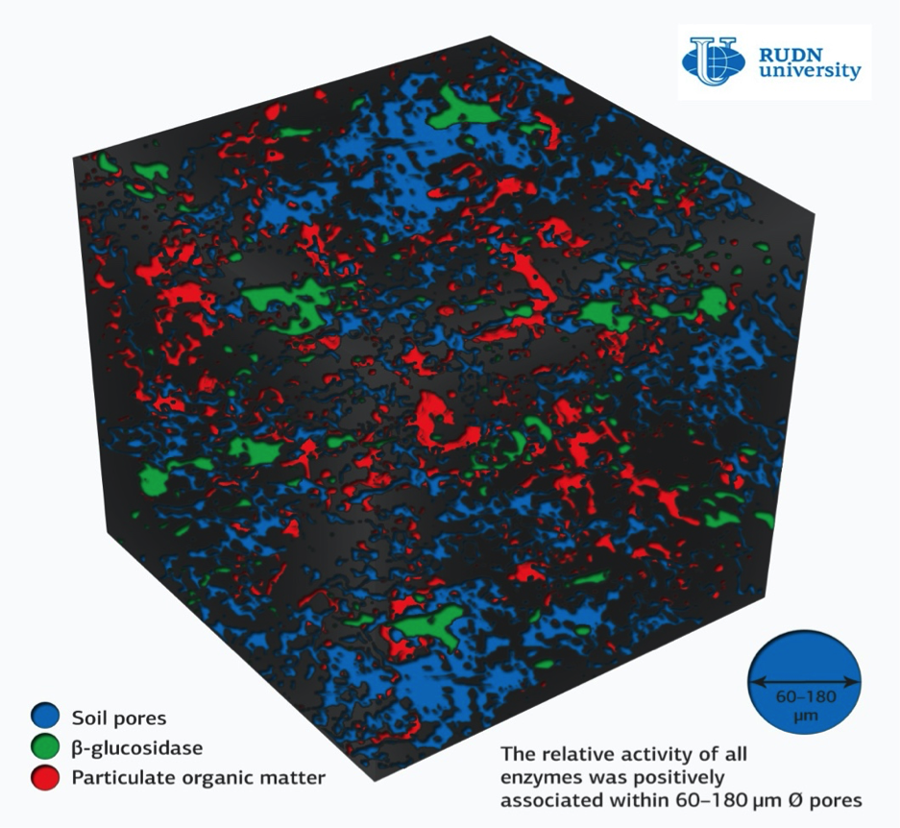Soil Scientists from RUDN University Have Determined the Optimal Size of Soil Pores for the Activity of Microorganisms
Soil types differ from each other not only in their chemical properties, but also in their location, shape, and pore size. Although any soil has both small and large pores, their ratio may be different. Larger pores (from 100 micrometers) are filled with air and are located between the soil lumps, small pores (10-100 micrometers) inside the lumps are filled with water. The pores are home to colonies of microbes that are responsible for biochemical reactions associated with the circulation of carbon, phosphorus, nitrogen and other chemical elements. Microorganisms improve soil fertility and carbon sequestration, so understanding what parameters (including pore sizes) determine the ‘well-being’ of microorganisms will help farmers increase yield.
Previously, the distribution of enzymes that secrete soil microorganisms was associated only with the chemical and biological properties of the soil. However, the physical structure of the soil also affects beneficial microbial communities and, consequently, enzymes. For the first time, soil scientists from RUDN University found optimal parameters of soil pores for microbial communities. To do this, they examined the pores using soil 2D-zymography — a biochemical method for studying the activity of enzymes, and X-ray computed tomography.
Soil samples from five land-use systems were taken from plots prepared for experiments by The Kellogg Biological Station in Michigan (USA): soil on which only corn was grown (1); white rye (2); millet (3); hybrid poplar with grassy undergrowth, (4) and soil on which plant communities successively changed as a result of natural factors or human activity (5). There were no live roots in the samples, meaning all the enzymes are produced by microorganisms.
To determine the distribution and size of pores in soils, samples measuring 5-10 centimeters were scanned with X-rays. Enzyme activity was mapped using zymography. Special membranes with substrates were placed on the surface of the samples, which emit fluorescent products upon contact. These products display the activity of enzymes in ultraviolet light. We studied the enzymes involved in the turnover of carbon, nitrogen and phosphorus in the soil: cellobiohydrolase, xylonase, acid phosphatase, β-glucosidase, leucinaminopeptidase and N-acetylglucosaminidase. Combining zymography and computer microtomography data allowed creating 3D maps that visualize the size of soil pores and enzyme activity in an intact soil sample.
In all the studied soil samples, regardless of the type, the most enzymes (and therefore the highest activity of microorganisms) were observed in pores with a diameter of 60-180 micrometers. Therefore, pores of this size are an ideal habitat for soil microbes. In smaller or larger pores, the activity of all six enzymes was less. Whole microbial colonies are located in the pores of this size (60-180 microns), and the access of water and oxygen is optimal. In the pores of this size (60-180 microns), more small roots grow, which provides greater saturation of the soil with readily available carbon. Thus, the size of soil pores does affect the distribution of enzymes.
The experiment confirmed for the first time that the combination of these two methods is effective for studying enzymes. In the future, soil scientists plan to improve the resolution of images and take into account additional factors such as fresh carbon intake, soil moisture and acidity. This will provide more accurate data and strengthen understanding of biochemical processes in situ — in the place where they occur, without any interference.
Article in Soil Biology and Biochemistry

The RUDN University Science and Innovation Prize winners were honoured at the extended meeting of the Academic Council. In 2024 the terms of the traditional RUDN University Prize were changed: for the first time the competition was announced in two categories: leading scientists and young scientists.
According to the International Energy Agency (IEA), electricity consumption in Africa has increased by more than 100% over the past two years (2020-2022). However, 74.9% of this energy is still produced by burning organic fuels — natural gas, coal and oil. At the same time, the level of electrification on the continent remains extremely low — only 24%, while in other developing countries it reaches 40%. Even in grid-connected areas, electricity supply is often unreliable: industrial enterprises lose energy on an average of 56 days a year.
Today, diagnosis and treatment planning with orthodontists takes several days. Also, complications can arise during treatment that slow down the patient's recovery process. For example, improper orthodontic treatment planning can lead to temporomandibular joint dysfunction.
The RUDN University Science and Innovation Prize winners were honoured at the extended meeting of the Academic Council. In 2024 the terms of the traditional RUDN University Prize were changed: for the first time the competition was announced in two categories: leading scientists and young scientists.
According to the International Energy Agency (IEA), electricity consumption in Africa has increased by more than 100% over the past two years (2020-2022). However, 74.9% of this energy is still produced by burning organic fuels — natural gas, coal and oil. At the same time, the level of electrification on the continent remains extremely low — only 24%, while in other developing countries it reaches 40%. Even in grid-connected areas, electricity supply is often unreliable: industrial enterprises lose energy on an average of 56 days a year.
Today, diagnosis and treatment planning with orthodontists takes several days. Also, complications can arise during treatment that slow down the patient's recovery process. For example, improper orthodontic treatment planning can lead to temporomandibular joint dysfunction.